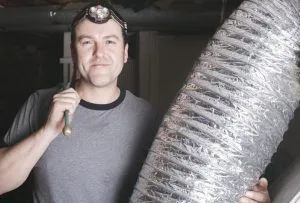
With a properly functioning HVAC system, you’ll enjoy comfortable airflow coming out of your ducts and cooling your home. This is a crucial part of maintaining adequate home comfort in the warm Henderson, Nevada, weather. If your home isn’t getting enough airflow, your ducts are one of the most likely causes. Check out your ductwork to see if one of these common problems is to blame for your uncomfortable situation.
Clogged Ducts
It’s rare that you’ll take a peek inside your ductwork. These passageways remain relatively unseen and may harbor untold hazards. If your home wasn’t new when you purchased it, the dust, dirt, and pollution that has built up in your ductwork may be the accumulated work of several prior residents. Dirty ducts can become clogged over time. Particularly filthy areas may have a buildup of dirt that restricts the airflow.
Even if the airflow isn’t noticeably impacted in your ducts, these problem areas may reduce the indoor air quality. This leads to a host of other problems including headaches, respiratory problems, and fatigue. You can clear any potential problem areas in your ducts by scheduling a duct cleaning with a reputable company.
Leaks in the Ductwork
Poor airflow is a prime indicator of leaky ductwork. It’s almost impossible to see leaks in your ductwork, yet most homes lose a significant amount of air through poorly sealed ductwork. The best solution for poor airflow is to have your ducts efficiently sealed with the Aeroseal duct sealing process. Unlike tapes or mastic, Aeroseal will not break down over time. This is a one-time solution with lasting effectiveness.
The Aeroseal duct sealing process begins with a technician sealing and pressurizing the HVAC system. A fog of Aeroseal sealants is pumped into the system. Thanks to the added pressure, the sealant will naturally target leaky areas in your ducts. This will instantly eliminate around 90 percent of the leaks in your ducts, improving air flow and immediately increasing your energy efficiency.
Poor Ductwork Design
Most homeowners are fairly unaware of how their ductwork is laid out. It’s largely out of sight and not something that you’d think about often. If you’re experiencing airflow problems, however, it’s time to take a closer look at what’s going on in your ducts. Head up to your attic, out to your garage, or anywhere else that you can see your ductwork, and take a peek.
Some ductwork problems are immediately apparent. If you’re not the first homeowners of your property, the previous residents may have performed any number of DIY jobs. Any sign of duct tape or DIY rigging indicates a poorly managed repair job that needs another look. An HVAC professional can better inspect your ductwork and identify specific areas where poor design or botched repairs may restrict proper airflow.
Undersized Systems
are often undersized, even by builders who should know better. Smaller ducts don’t always result in lower heating and cooling costs. In fact, ducts that are too small will simply slow down air flow and force your HVAC system to work harder for less efficient results. Have your HVAC technician take a look at your ducts and see if they’re the right size for your home.
Lack of Insulation
Are your ducts insulated? If not, you’re likely facing a host of problems. Poorly insulated ductwork doesn’t transfer cool air as efficiently because the air comes into contact with warm ducts throughout its journey. Uninsulated ducts also accumulate condensation when it’s hot outside the ducts but cold inside or vice versa. Condensation can drip in your ceilings and create a welcoming environment for mold and mildew, which reduce indoor air quality.
Though the lack of insulation doesn’t directly slow airflow, it can give a similar effect because the air that comes out won’t feel as cold as it should, leading you to believe that you’re losing air somewhere in your ducts.
If you need help improving airflow through the ducts in your home, contact Ambient Edge. We offer Aeroseal duct sealing services that will eliminate leaks and make sure you’re not losing any of the precious cooled air that you’re pumping through your home.
Image provided by Shutterstock



